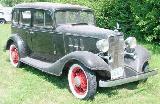
 After my adventures with my first Model T‚ Ford, I was offered a 1933 Chevrolet sedan as an even trade. Wow! Four wheel brakes and a real clutch. On Broadway, the main street of Seattle’s Capital Hill area, there were many car dealers lodged in multi-story old brick buildings. On the third floor of one, I was pointed to a dust covered pea soup green car with yellow wire wheels, six of them as it had a spare in each front fender. It had a six-cylinder overhead valve 60 Hp engine, which, after some gas down the carb and a fresh battery, burst into life in a thick cloud of blue smoke and a clattering of loose tappets. Once on the street, my trader handed $65 over to the car dealer, papers were signed and off I went, proud owner of my third car. I had just turned 15.
After my adventures with my first Model T‚ Ford, I was offered a 1933 Chevrolet sedan as an even trade. Wow! Four wheel brakes and a real clutch. On Broadway, the main street of Seattle’s Capital Hill area, there were many car dealers lodged in multi-story old brick buildings. On the third floor of one, I was pointed to a dust covered pea soup green car with yellow wire wheels, six of them as it had a spare in each front fender. It had a six-cylinder overhead valve 60 Hp engine, which, after some gas down the carb and a fresh battery, burst into life in a thick cloud of blue smoke and a clattering of loose tappets. Once on the street, my trader handed $65 over to the car dealer, papers were signed and off I went, proud owner of my third car. I had just turned 15.
The car had a 3-speed transmission and free wheeling‚, actuated by pulling a knob on the dashboard. It was like being in neutral, coasting without using the engine as a brake. This modern device, designed by the Satan Division of General Motors, featured on many cars in the early 1930’s coupled with mechanical brakes, helped slow our nation’s population growth. It was supposed to reduce wear and extend the life of the car but in practice, reduced the life of both car and driver.
This thing smoked a lot, clouds rolling up from under the dashboard burning my eyes and making me sick. Keeping all of the windows down regardless of the weather kept me from passing out. When I ran over the front bumper, it took the muffler and tailpipe with it. Being a resourceful (and broke) kid, I robbed a down spout from the house and used it to funnel smoke and noise towards the back of the car.
General Motor’s car bodies were framed with wood, making them rattle free, unlike a Ford. But the doors sagged when opened. Chevy out-sold Ford in those days but there very few left today, thanks to dry rot. All six tires looked great but every time I went anywhere, I had a flat. I began a career of fixing flats along the road with screwdrivers, a hammer, patch kit and a tire pump, that lasted me through many future cars. Along with the noisy tappets and heads hanging from the open windows to breathe, conversation was impossible, but few would accept a ride anyway.
I did have one unforgettable race with this car. My friend Stan bought a ’34 Chev coupe and one night found us racing down a steep hill towards Puget Sound. We were side by side, wide open and tied. Luckily, when we reached the end of the road, we were able to brake hard enough to turn, (me to the left, him to the right) without rolling over or going into the water.
I didn’t think I was hard on the car but the engine soon began to knock, all six con rods began a fatal chorus. I found that Chevrolet sixes and I didn’t get along very well, (a later ’39 coupe convinced me). My nieghbor called the engine design “a cast iron clatter and splash.” As pretty as it was, this car went off to the junk yard, the first of many. I was soon to be introduced to Mr. Ford’s flathead V-8, starting an affair that has lasted well into my retirement years.